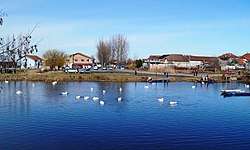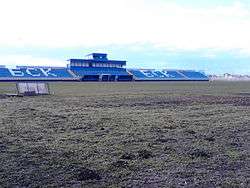Vizelj
The Vizelj (Serbian: Визељ) is a short channeled river in north-central Serbia, the left tributary to the Danube. During its entire flow it runs through the suburban section of Belgrade, on the territory of municipality of Palilula.
| Vizelj Визељ | |
|---|---|
| Location | |
| Country | Serbia |
| Physical characteristics | |
| Source | |
| • location | north of Padinska Skela, Serbia |
| Mouth | |
• location | Danube, at Krnjača, Serbia |
• coordinates | 44.833917°N 20.470393°E |
| Length | 31 km (19 mi) |
| Basin features | |
| Progression | Danube→ Black Sea |
Course and geography

Vizelj originates north of Padinska Skela, in the central part of the Pančevački Rit, a former marshland in the southwestern corner of the Banat region. The course of the river is in the north-to-south direction and is generally full of curves and meanders. It flows through Padinska Skela and Kovilovo, before it is being crossed by the Northern Tangent, in wider sense, a northern part of the Belgrade bypass. From there, meandering in the east-west direction, it flows on the west border of the urbanized area of Borča (neighborhoods of Mali Zbeg, Nova Borča and Stara Borča). After exiting Borča, it receives the western section of the channeled streams of Mokri Sebeš from the left and Veliki Kanal from the right side, crosses the embankment which protects the inland from the Danube and turns to the southeast. Flowing on the southern border of the neighborhood of Kotež, it empties into the Danube at its 1,168.5 km (726.1 mi). It forms the entire eastern border of the ada of Kožara, and that entire section is projected as the future much larger Čaplja island. The final 2 km (1.2 mi) of Vizelj are also known as the Jojkićev Dunavac, named after the former mayor of Belgrade Đurica Jojkić, as during his tenure that section was channel and widened in an effort to quicken the drainage of the Pančevački Rit. Weekend settlement Mika Alas is located at the very confluence of the Vizelj.[1][2][3][4]
The length of the Vizelj, due to the channeling and artificial connections with the surrounding channels, has been reported as either 27 km (17 mi) or 31 km (19 mi). The average width of the stream is 50 m (160 ft) and is 1.5 to 2 m (4 ft 11 in to 6 ft 7 in) deep.[5] During the normal and high water levels, smaller vessels can enter the channel, but during the low waters it is inaccessible.[4] However, it is used for kayaking since 1972, when the first kayak club in Borča was founded.[6]
Human history

Initial works on the river were done in the 18th century, during the reign of the empress Maria Theresa, as the area was ruled by Austria at the time.[5] In the mid-20th century, the Vizelj was navigable for smaller vessels. The navigable waterway was starting at Vrbovski, and continued until Reva, where it reached the Danube.[7] In the early 1960s, with the digging of the Jojkićev Dunavac, the stream was extended and got its present form. As the area became rapidly urbanized after the World War II, which was not followed by the adequate communal infrastructure, the Vizelj got more and more polluted.[5]
It was partially cleaned in 2009. In 2012 sisters Nikolina Moldovan and Olivera Moldovan, who practiced on the Vizelj, petitioned to the mayor Dragan Đilas to do something about the worsening conditions of the river as it is important for the national sport. City decided to financially support the cleaning, though that is not administratively under the city jurisdiction. In August–September 2012 the stream was dredged, cleaned and the vegetation was cut.[5] Yearly kayaking regattas have been organized since then. In 2014 the channel was cleaned again but by May 2015 it was again covered in vegetation and turned into the morass.[8] The river was cleaned during the summer of 2015.[9] Since then, locals and members of the kayaк clubs organized and regularly clean the stream, including the cleaning of the banks in April 2017.[6][10]
In April 2014, during the repair of the waste water collector, toxic substances were poured into the river which caused a massive fish kill.[11] In August 2014, the agricultural company PKB apparently discharged large amounts of ammonia into the Vizelj which nearly killed the entire fish population.[12][13] Despite the pollution, the river is popular among the fishermen, but the recreational fishing is forbidden on the course of 600 m (2,000 ft), between river's 3rd and 4th kilometer.[14]
In the autumn of 2010 a flock of 30 swans landed on the Vizelj and have been coming every years since then, and the number of swans doubled. They became a local attraction.[9][6] However, the area was plagued by the avian influenza in January 2017, which killed almost 40 swans.[15]
In March 2019, the environmentalists described the Vizelj as "less of a watercourse, more of a sewage watershed".[16] Some cleaning of the canal was conducted after the floods in 2019.[7] Jojkićev Dunavac, which makes the final section of the stream, is actually a 6 km (3.7 mi) long canal, cut in the 1950s to drain the soil. In Borča, there is a pumping station which transfers the water from this stream into the Mokri Sebeš. By 2020, the communal services which cut the poplars in the surrounding fields, left the cut trees and debris which clogged the final section, cutting it off from the Danube, and turning Jojkićev Dunavac into the bog. As a result, the water turned black and the fish kill and dying of swans and ducks continued.[17]
Vizelj is name of the PKB's pig farm. Also, a new stadium of the FK BSK Borča, built in the vicinity of the river in 2009, is named Vizelj Park.
Glutin complex
Glutin industrial complex is located in the Padinska Skela Industrial Zone, along the promenade on the Vizelj's bank. The state-owned factory was processing dead animals and animal waste, tanning leather and producing animal glue. Due to the bad conditions in the company, workers began to strike in 2005 and the processing of the waste completely stopped. In 2012 the government donated money to the company so that it could process the enlarging amount of the waste, but the strike was only radicalized in 2012 and 2013. The Gluten went bankrupt and was officially closed.[18][19]
During the inspections of the gradually ruining complex in February 2019 by the ecologists and reporters, over 300 tons of fossilized animal carcasses and bare bones were found. Additionally, mazut, the tanning fluids and various other unidentified chemicals are spilled over within the complex. There is also numerous hardened and crystalized waste, all left to the elements in the open. The ground was soaked by the large amount of toxic waste, while the animal remains are scattered by the stray dogs, jackals and foxes. The area is full of fumes and "unbearable stench".[18][19]
The central collector pool for the waste waters from the PKB company is still operational within the complex. PKB's tank trucks poor the waste into the collector, from were it goes directly, unfiltered, into the Vizelj. The Glutin has been described as an ecological bomb and the "Sword of Damocles of the Pančevački Rit". The proposed solutions by the ecologists include the incineration of the waste in the furnaces of the cement factory in Beočin. Problem is deepened by the fact that the owner of the lot on which the waste is located is unclear, even in the official cadastre books. Also, all government ministries and agencies claim that the problem is not under their jurisdiction.[18][19]
The complex covers an area of 330 a (360,000 sq ft) and is 500 m (1,600 ft) away from the urbanized area of Padinska Skela.[20] It is used as the shooting range by the airsoft teams, while the bones are collected for the filming of musical and video clips, etc.[18]
Since none of the institutions accepted the responsibility for the problem, city administration in the end organized the removal of the waste which began in July 2019. It is being transported to the "Proteinka" factory in Sombor for treatment. Due to the distance (Sombor is 150 km (93 mi) away from Belgrade) and the specificities of the waste treatment, only one truck weekly will transport the bones, so it is planned for the proncess to lasts for several months.[21] The transport was intensified and the bones were completely removed by the end of August 2019.[22]
References
- Beograd - plan i vodič. Geokarta. 1999. ISBN 86-459-0006-8.
- Beograd - plan grada. M@gic M@p. 2006. ISBN 86-83501-53-1.
- Turističko područje Beograda. Geokarta. 2007. ISBN 86-459-0099-8.
- "Ono što znamo i ne znamo o Dunavu" (in Serbian). Plovidba info. 20 August 2009.
- Nikola Belić (21 August 2012), "Kanal VIzelj će biti kajakaška oaza", Politika (in Serbian)
- Č.L. (26 March 2016). "Neverovatna slika u Borči: Zabeleo se kanal" (in Serbian). Blic.
- Branka Vasiljević (11 August 2020). "Sprečena ekološka katastrofa u kanalu Vizelj" [Ecological catastrophe prevented in the canal Vizelj]. Politika (in Serbian). p. 14.
- Marija Kosanović (31 May 2015). "Očajni uslovi u kojima treniraju kajakaši iz Borče" (in Serbian). Blic.
- "Oaza mira i prirode koju su svi zaboravili" (in Serbian). Koreni. 1 December 2015.
- "Uređenje obale kanala Vizelj u Borči" (in Serbian). Zelena lista Srbije. 22 April 2017.
- M.Lj.Ppopović (21 April 2014). "Pomor ribe u borčanskom kanalu Vizelj" (in Serbian). Večernje Novosti.
- M. Jovićević (4 August 2014). "Mrtve ribe ponovo plutaju po Vizelju" (in Serbian). Blic.
- Marija Kosanović (5 August 2014). "Borčanci jeli otrovanu ribu?!" (in Serbian). Blic.
- "Fishery area "Belgrade"". Srbijašume. 2016.
- Ana Ristović (27 January 2017). "Od ptičjeg gripa uginulo 39 labudova". Blic.
- Branka Vasliljević (23 March 2019). "Sava i Dunav odolevaju zagađenju, rečice i potoci postali kolektori" [Sava and Danube resist the pollution, streams and brooks turned into collectors]. Politika (in Serbian). p. 12.
- Branka Vasiljević (29 July 2020). "Jojkićev dunavac i dalje bez života" [Jojkićev Dunavac still lifeless]. Politika (in Serbian). p. 14.
- Branka Vasiljević (19 February 2019). "Ekološka bomba na dvadesetak kilometara od centra grada" [Ecological bomb at 20 kilometers from downtown]. Politika (in Serbian). p. 1 & 17.
- Branka Vasiljević (21 February 2019). "Za kosti u Padinskoj skeli niko nije nadležan" [No one has jurisdiction over the bones in Padinska Skela]. Politika (in Serbian). p. 16.
- Branka Vasiljević (28 February 2019). "Ekološki horor u Padinskoj skeli" [Ecological horror in Padinska Skela]. Politika (in Serbian). p. 14.
- Branka Vasiljević (4 July 2019). "Ekološki bomb iz Padinske Skele odlazi u spalionicu" [Ecological bomb from Padinska Skela transported to incinerator]. Politika (in Serbian). p. 13.
- Daliborka Mučibabić (29 August 2019). Уклоњено гробље костију из Падинске Скеле [Bones graveyard removed from Padinska Skela]. Politika (in Serbian). p. 15.